LOUISVILLE, Ky. (WDRB) -- As the Great Recession was taking hold in 2008, things were looking bleak at Ford Motor Co.'s Louisville Assembly Plant. Demand for its main product, the Explorer SUV, had tanked amid soaring gas prices. Output was down. Hundreds of jobs were cut.
Auto workers, union leaders and elected officials were grappling for answers: What would come next for the plant, known as LAP, a longstanding pillar of the Louisville economy?
The answer arrived in 2009, when Ford decided to give the plant a new product, and thus, new life. A spokesman for then-Mayor Jerry Abramson called it "a miraculous turnaround."
The Escape, Ford's popular compact crossover SUV, ushered in a new era of growth at LAP. Employment more than tripled from the waning days of the Explorer. Thousands more jobs were created at Louisville-area supplier plants serving LAP.
But now, the 68-year-old plant appears to be nearing another inflection point. With the Escape's sales sliding and Ford pouring billions into electrification, the future of LAP will be a top priority for United Auto Workers leaders when they negotiate a new four-year labor deal with Ford later this year.

Todd Dunn, president of UAW Local 862, which represents about 13,000 rank-and-file workers between Ford Motor Co.'s two Louisville plants.
"The focus right now is on Louisville Assembly Plant, making sure that we have product there and in every assembly plant in North America," said Todd Dunn, president of UAW Local 862, the chapter representing workers at LAP and at Ford's larger Kentucky Truck Plant in eastern Jefferson County. "... There is no other option than keeping that plant open."
In addition to wages and benefits for hourly workers, the UAW intends to secure commitments for vehicles at each of Ford's existing plants, an effort to "protect what we have," Dunn said.
Ford, for its part, wouldn't divulge long-term plans for the plant, which employs about 3,200 hourly workers. But in a statement, the Detroit-based automaker noted that the plant is working on the refreshed 2023 Escape and will soon get a new Lincoln Corsair, the higher-priced Escape derivative that is also built at LAP.
"Louisville Assembly Plant and our employees there are an important part of Ford's manufacturing operations," Ford spokeswoman Kelli Felker said. "Louisville Assembly is currently launching the new Ford Escape and Lincoln Corsair."
But, speaking at an investor conference last year, Ford CEO Jim Farley seemed to cast doubt on the future of the vehicle.
"We're going to have passion brands," Farley said. "We're not going to have commodity products like Edges and Escapes."
The Edge, another compact SUV, is expected to cease production by the end of 2023 as Ford retools the Canadian plant where it is made to build electric vehicles, industry publication Automotive News reported last month.

Ford Motor Co., President and CEO Jim Farley announces the automaker's new BlueOval Battery Park, Monday, Feb. 13, 2023, in Romulus, Mich. The automaker plans to build a $3.5 billion electric vehicle battery plant about 100 miles west of Detroit that would employ about 2,500 people. The plant was revealed Monday at a meeting of the Michigan Strategic Fund, which approved a large state tax incentive package for the project near the city of Marshall. (AP Photo/Carlos Osorio)
Compounding some workers' anxiety, LAP has been off and on for weeks amid a rocky launch of the new Escape. The plant is idle this week as Ford's engineering team seeks to iron out problems before restarting production.
RELATED: Ford idles Louisville Assembly Plant amid rocky launch of new Escape
"I've seen a lot of people getting on Facebook and talking doom and gloom, and this being bad for the plant — 'It doesn't look good for the plant; we're failing at our launch,'" said Brandon Reisinger, UAW 862's building chairman for LAP, in a Feb. 9 video message to plant workers.
In fact, Reisinger said, "That couldn't be any farther from the truth." The issues with the vehicle don't reflect on the performance of the assembly plant, which has been "top notch," he told members in the video.
"The units that we have ran have all been actually above expectation as far as our quality and our first-time through. And as far as our plant goes, we're doing the things that we need to do," Reisinger said. He did not respond to requests for comment.
'A really important vehicle to Ford'
Introduced in the early 2000s, the Escape is still one of Ford's highest-volume vehicles, but its sales have declined for five straight years, reducing its place in Ford's portfolio.
When sales of the compact SUV peaked along with the overall industry in 2017, the Escape accounted for 12% of Ford's U.S. sales. In 2022, the Escape made up 7% of Ford's U.S. sales, according to a WDRB analysis of company statistics.
Some of the Escape's decline is by design, according to industry analysts.
Ford in 2020 resurrected the Bronco, a similarly sized vehicle but with a boxier look, from its 1990s dustbin. The Bronco and Bronco Sport — which is more directly comparable to the Escape — outsold the Escape last year.
"We knew that the sales of Escape would not stay as high as they were because they built the Bronco Sport," said Michelle Krebs, executive analyst with Cox Automotive, parent company of Kelley Blue Book and Autotrader. The Bronco Sport "was more appealing; it was something new and different, and so it cannibalized on Escape sales, which Ford expected."
Krebs added that even the Maverick, an economical pickup truck that Ford introduced last year, may be taking a bit of market share from the Escape.
Meanwhile, some of the vehicle's depressed sales could be because of supply rather than demand. In 2021, when a sudden shortage of semiconductor chips roiled the industry, Ford prioritized bigger, more profitable vehicles like the F-Series Super Duty pickups made at Kentucky Truck Plant.
Plant-level production figures show Louisville Assembly Plant took the brunt of the chip shortage, as frequent shutdowns resulted in a 72% plunge in output in 2021 from the year before.
LAP's volumes bounced back last year, while Ford managed to keep Super Duty production steady over the three-year period.
The Escape's supply appears to be healthy as of January, according to Cox data. At 132 days of supply — a measure that tracks vehicle stocks relative to the pace of sales — the Escape has more inventory than any of the other 29 top-selling models in the industry.
The comparable Honda CR-V, on the other hand, had less than 20 days' supply, according to Cox.
Even amid declining sales, the Escape still plays a critical role in Ford's lineup, said Sam Fiorani, vice president of global vehicle forecasting at AutoForecast Solutions, an industry consulting firm.
As one of Ford's lowest-priced vehicles — its list price starts under $30,000 — the Escape brings first-time car buyers to Ford, he said. That's even more relevant after Ford stopped producing passenger cars in 2018 and decided last year to stop making the EcoSport, a subcompact SUV.
"This is a really important vehicle to Ford, as new buyers come in and see this as the closest thing Ford has to a car," Fiorani said.

Marty Book, shown July 14, 2021, is president at Carriage Ford in Clarksville, Ind.
Marty Book, president of Carriage Ford, a dealership in Clarksville, Ind., said his business sold more Escapes last year than in 2021, bucking the overall trend.
He praised the vehicle's mass-market appeal.
"My mother has driven one for the last 10-15 years. She's 90 years-old now. By the same token, parents will come and buy it for their kids for a first car," Book said. "It really has the widest range of typical customer of anything we sell."
Shift to EVs
Another looming question is what Ford's concerted push into electric vehicles means for the Escape and for LAP. Ford aims for EVs to make up half its sales by 2030.
Across town at Kentucky Truck Plant, the EV revolution doesn't portend much change in the foreseeable future, as there is plenty of demand for the large, gas-powered pickup trucks made there and technological barriers to reproducing their power in electric form.
"What we're producing here with the Super Duty and the capability it provides for our customers, we just don't have — nobody has — the technology today to do what our customers expect (in electric form), so we think we have a long and strong future here," Ford vice president John Savona told WDRB News in September.
Ford makes hybrid-electric versions of the Escape, including plug-in hybrids that drive nearly 40 miles on battery power. It has not announced a pure EV for the nameplate.
AutoForecast Solutions sees that changing in the next few years. The company predicts LAP transitioning to build Escape EVs by 2026, Fiorani said.
Whether the plant converts to producing only EVs or maintains a mix of gas-powered and EV Escapes depends on how quickly consumers adopt electric cars, Fiorani said.
"Keeping a hybrid version around or keeping the full (internal combustion engine) version, as well as the new EV, is definitely part of a potential plan going forward," he said.

Ford Motor Co. and its Korean partner SK On are building a pair of battery factories in Glendale, Kentucky, which are expected to churn out power sourcing for 1.3 million electric vehicles by 2026. The $5.8 billion BlueOval SK Battery Park began construction in October 2022 and is expected to open in 2025. Dec. 5, 2022.
One reason for optimism about LAP's future can be found 45 miles south in Hardin County, where Ford and its Korean partner SK Innovation are spending $5.8 billion to construct a pair of EV battery plants.
"That just made this assembly plant (LAP) even more viable," said Dunn, the local union leader. "So many more options can be brought to it."
To be sure, converting to EVs raises questions about jobs. EVs are mechanically simpler than gas-powered cars.
"The physical assembly of the vehicle in the long term will take fewer people to do," Fiorani said.
There's also a robust set of supplier plants making parts used in the current, gas-powered Escape and Lincoln Corsair.
But other parts will be needed for EVs and new jobs will be created, Fiorani said. The battery plants in Glendale, Ky., project hiring 5,000 people alone.
Fiorani added that in the next decade or two, assembly plants that don't produce EVs will face decommissioning.
"We're expecting electrics to take over, not in the next few years, but in the long term," he said. "So making this a fully electric plant would be the best outcome for the local workers."






